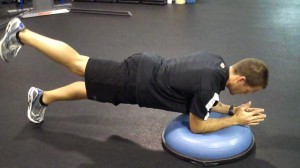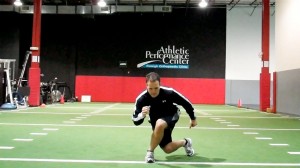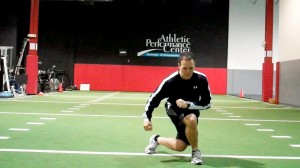Brian Schiff’s Blog
Injury Prevention, Sports Rehab & Performance Training Expert
I have had the pleasure of authoring a bi-weekly column for PFP’s online magazine entitled “Functionally Fit” for over three years now. This column gives me a creative avenue to display my specific training techniques and teach others how to build a better functional body in the process.
One of the greatest things about exercise is all the different options, variations and tweaks available to bring about a desired physical change in the human body. As Alwyn Cosgrove once said, “Exercise is like medicine.” By this, he means the right dosage and application is critical. I could not agree more.
As training and rehab continue to evolve and become even more intertwined, we as practitioners need to continue seeking ways to get more from our exercises. I personally use lots of different training tools in my trade, but I am always seeking to get the biggest return on my exercise investments. Today, I am sharing one such exercise with you, the 3D Mountain Climber with Hip Extension. Check out the video below:
In this video, I am working to improve shoulder, hip and core stability as well as strongly encourage hip disassociation. Many clients I train and rehab simply are asymmetrical or cannot disassociate their hips which leads to flawed movement patterns and leaks int he kinetic chain.
I used this exercise in our core training series we were doing with the Carolina Hurricanes in their pre-season conditioning sessions that we just recently completed. It is not easy, but delivers so much benefit for just one movement. In the video I display a BOSU balance trainer, but in my online column for PFP, I include a full buildup progression as well. Click here to read the column.
So, conventional wisdom and research continues to point to the need for promoting increased gluteus medius and maximus strengthening to promote better knee stability and ward off many other kinetic chain breakdowns. While there are many examples of how to train these muscles, the question is what are the best exercises to promote hypertrophy of these groups.

Whether training or administering rehab, it is important to understand how best to activate these muscles as time may be limited. I think it bears mentioning that core function is closely tied to pelvic posture/alignment so it will be no surprise as you see the best exercises in this post according to recent research released in the International Journal of Sports Physical Therapy. To promote muscle strength, higher MVIC correlates to better strength gains. So, looking at the %MVIC of exercises clinicians and fitness pros alike can better rank the order and appropriateness of certain exercises to maximize health and performance of their clients.
According to a the study at Belmont University, the authors looked at 18 different exercises using surface EMG to study activation of the gluteus maximus and medius. Below is a summary of the top 5 exercises stimulating greater than 70% MVIC for each muscle group:
Gluteus Medius
- Side plank abduction with dominant leg on bottom (103% MVIC)
- Side plank abduction with dominant leg on top (89% MVIC)
- Single leg squat (83% MVIC)
- Clamshell 4 (hip clam – 77% MVIC)
- Front plank with hip extension (75% MVIC)
Gluteus Maximus
- Front plank with hip extension (106% MVIC)
- Gluteal squeeze (81%)
- Side plank abduction with dominant leg on top (73% MVIC)
- Side plank abduction with dominant leg on bottom (71% MVIC)
- Single leg squat (71% MVIC)
Click here to read the abstract of the study. I think it is fairly obvious based on the data presented in the article that core stability and training should be integrated with hip strengthening. I presented a column in Functionally Fit last year on plank with hip extension and abduction using a BOSU. This is more advanced concept than just the traditional plank, but a very good exercise. See the picture below:

Click here to read the entire column on the BOSU plank with hip extension/abduction. This particular exercise requires hip disassociation and core stability. I just finished a new column for PFP Magazine on BOSU clamshells so stay tuned for that one as it reveals a side lying progression to optimize hip strength as well.
I think most people involved in health and fitness are up to speed on the move to address mobility and stability at the hip as an integral part of our assessments and exercise prescription. I know in my practice I see lots of issues with both a lack of hip stability and mobility.
As I learn, practice and evolve as a professional, I find myself looking for more bang for my buck with exercises. A few themes and trends in my own training include:
- Increasing emphasis on body weight exercises
- More and more single leg training
- Integrated movement patterns versus isolation
So, if you are familiar with Gray Cook and Mike Boyle (I am specifically referring to their writing and discussion on the joint by joint approach) you know that they advocate for increasing mobility at some joints and gaining stability at others. Ironically, the hip has a need for more of both depending on the movement and individual imbalances.
So, I really enjoy exercises that provide some of each and meet the trends I referenced above. I just released one such hip exercise in my “Functionally Fit” Column in PFP Magazine. I call it the RDL Hip Driver.


Click here to read the entire post with a full description of how to perform the exercise and its functional application.
First off, I want to extend warm Holiday wishes to all of you reading this blog!! As I sit at home on Christmas Eve morning, I am quietly reflecting back on a big year of accomplishments and changes I experienced in 2010. It is often hard to take time to appreciate your blessings, Because as a society we are driven to conquer the “next thing.” However, I have been trying to get better at taking time to savor life’s victories.
Last year, I ran my first marathon (thankfully under 4 hours despite horrible cramps), sold my successful 10 year-old fitness business in Ohio, and moved to North Carolina to tackle a new venture at the Athletic Performance Center. The past year has truly been full of many changes and blessings.
Over the years, I have come to realize that the real gift in my profession is being able to help others. For me, I have an ability to reach consumers through my rehab and performance training, as well as my peers through blogging, speaking and products. If you read my blog, I hope that I have been able to help you even if it is only in the smallest way.
As I look ahead to 2011, I am excited for new opportunities and feel like it will be a big year of learning and exploration for me. That will translate into more sharing on this blog and in my monthly Training & Sports Medicine Update Newsletter. I am continuing to write for PFP Magazine through my online column and will share my latest post with you today on crossing lunges.
Performing a crossing lunge presents unique challenges to the body – challenges which often exploit muscle imbalances, mobility issues, and balance deficits. It is a rotational activity that is more challenging then it may appear.
I once had an athletic trainer question the safety of them in an exercise class I was teaching. She thought they were harmful for the meniscus in the knee. Hmmm…. If that is true , why would I do them? Well, like any exercise you do in the gym, there is always risk of an injury IF you do the exercise improperly. That is a key takeaway point. For the record, I never recommend an exercise I think is dangerous – in most cases it simply comes down to form and knowing your limitations.
Crossing lunges are very effective in strengthening the entire lower body, but particularly the hips. Whether choosing the backward or forward variation, they call for hip internal/external rotation, knee stability and ankle mobility. Beyond that, they are very functional for sport and athletic movement.
Think about field or court sports for a minute. How many times does an athlete cross over to dribble, scoop up a ball or evade a tackle? You may see the forward variation more, but the backward variation is seen as well with drop steps, pivot motions and even along the baseline in tennis.
So, if you train athletes or are an athlete, this is a great example to keep in your personal exercise tool box. I have included pictures of the forward and backward version below. See the link below the photos for my full column and explanation of how to do the exercise properly.

Backward Crossing Lunge (onto right)

Forward Crossing Lunge (onto right)
Click here to read my full online column, Functionally Fit, pertaining to this lunging exercise. Thanks for reading this, and I wish you all the best in the year to come!

